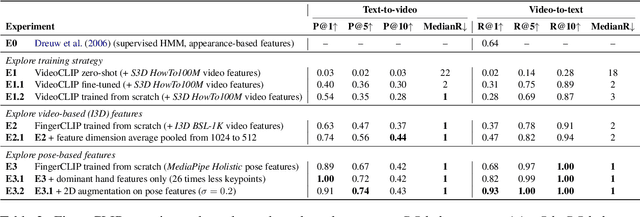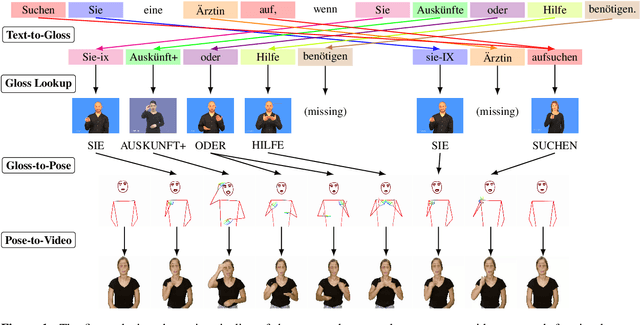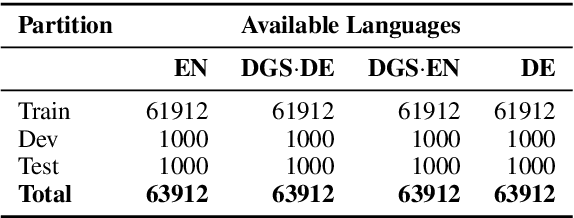Sarah Ebling
Digitally Supported Analysis of Spontaneous Speech (DigiSpon): Benchmarking NLP-Supported Language Sample Analysis of Swiss Children's Speech
Apr 01, 2025Abstract:Language sample analysis (LSA) is a process that complements standardized psychometric tests for diagnosing, for example, developmental language disorder (DLD) in children. However, its labor-intensive nature has limited its use in speech-language pathology practice. We introduce an approach that leverages natural language processing (NLP) methods not based on commercial large language models (LLMs) applied to transcribed speech data from 119 children in the German speaking part of Switzerland with typical and atypical language development. The study aims to identify optimal practices that support speech-language pathologists in diagnosing DLD more efficiently within a human-in-the-loop framework, without relying on potentially unethical implementations that leverage commercial LLMs. Preliminary findings underscore the potential of integrating locally deployed NLP methods into the process of semi-automatic LSA.
Multimodal Emotion Recognition and Sentiment Analysis in Multi-Party Conversation Contexts
Mar 09, 2025Abstract:Emotion recognition and sentiment analysis are pivotal tasks in speech and language processing, particularly in real-world scenarios involving multi-party, conversational data. This paper presents a multimodal approach to tackle these challenges on a well-known dataset. We propose a system that integrates four key modalities/channels using pre-trained models: RoBERTa for text, Wav2Vec2 for speech, a proposed FacialNet for facial expressions, and a CNN+Transformer architecture trained from scratch for video analysis. Feature embeddings from each modality are concatenated to form a multimodal vector, which is then used to predict emotion and sentiment labels. The multimodal system demonstrates superior performance compared to unimodal approaches, achieving an accuracy of 66.36% for emotion recognition and 72.15% for sentiment analysis.
Two-Stream Spatial-Temporal Transformer Framework for Person Identification via Natural Conversational Keypoints
Feb 28, 2025Abstract:In the age of AI-driven generative technologies, traditional biometric recognition systems face unprecedented challenges, particularly from sophisticated deepfake and face reenactment techniques. In this study, we propose a Two-Stream Spatial-Temporal Transformer Framework for person identification using upper body keypoints visible during online conversations, which we term conversational keypoints. Our framework processes both spatial relationships between keypoints and their temporal evolution through two specialized branches: a Spatial Transformer (STR) that learns distinctive structural patterns in keypoint configurations, and a Temporal Transformer (TTR) that captures sequential motion patterns. Using the state-of-the-art Sapiens pose estimator, we extract 133 keypoints (based on COCO-WholeBody format) representing facial features, head pose, and hand positions. The framework was evaluated on a dataset of 114 individuals engaged in natural conversations, achieving recognition accuracies of 80.12% for the spatial stream, 63.61% for the temporal stream. We then explored two fusion strategies: a shared loss function approach achieving 82.22% accuracy, and a feature-level fusion method that concatenates feature maps from both streams, significantly improving performance to 94.86%. By jointly modeling both static anatomical relationships and dynamic movement patterns, our approach learns comprehensive identity signatures that are more robust to spoofing than traditional appearance-based methods.
SwissADT: An Audio Description Translation System for Swiss Languages
Nov 22, 2024Abstract:Audio description (AD) is a crucial accessibility service provided to blind persons and persons with visual impairment, designed to convey visual information in acoustic form. Despite recent advancements in multilingual machine translation research, the lack of well-crafted and time-synchronized AD data impedes the development of audio description translation (ADT) systems that address the needs of multilingual countries such as Switzerland. Furthermore, since the majority of ADT systems rely solely on text, uncertainty exists as to whether incorporating visual information from the corresponding video clips can enhance the quality of ADT outputs. In this work, we present SwissADT, the first ADT system implemented for three main Swiss languages and English. By collecting well-crafted AD data augmented with video clips in German, French, Italian, and English, and leveraging the power of Large Language Models (LLMs), we aim to enhance information accessibility for diverse language populations in Switzerland by automatically translating AD scripts to the desired Swiss language. Our extensive experimental ADT results, composed of both automatic and human evaluations of ADT quality, demonstrate the promising capability of SwissADT for the ADT task. We believe that combining human expertise with the generation power of LLMs can further enhance the performance of ADT systems, ultimately benefiting a larger multilingual target population.
Audio Description Generation in the Era of LLMs and VLMs: A Review of Transferable Generative AI Technologies
Oct 11, 2024Abstract:Audio descriptions (ADs) function as acoustic commentaries designed to assist blind persons and persons with visual impairments in accessing digital media content on television and in movies, among other settings. As an accessibility service typically provided by trained AD professionals, the generation of ADs demands significant human effort, making the process both time-consuming and costly. Recent advancements in natural language processing (NLP) and computer vision (CV), particularly in large language models (LLMs) and vision-language models (VLMs), have allowed for getting a step closer to automatic AD generation. This paper reviews the technologies pertinent to AD generation in the era of LLMs and VLMs: we discuss how state-of-the-art NLP and CV technologies can be applied to generate ADs and identify essential research directions for the future.
Modelling the Distribution of Human Motion for Sign Language Assessment
Aug 19, 2024



Abstract:Sign Language Assessment (SLA) tools are useful to aid in language learning and are underdeveloped. Previous work has focused on isolated signs or comparison against a single reference video to assess Sign Languages (SL). This paper introduces a novel SLA tool designed to evaluate the comprehensibility of SL by modelling the natural distribution of human motion. We train our pipeline on data from native signers and evaluate it using SL learners. We compare our results to ratings from a human raters study and find strong correlation between human ratings and our tool. We visually demonstrate our tools ability to detect anomalous results spatio-temporally, providing actionable feedback to aid in SL learning and assessment.
SignCLIP: Connecting Text and Sign Language by Contrastive Learning
Jul 01, 2024



Abstract:We present SignCLIP, which re-purposes CLIP (Contrastive Language-Image Pretraining) to project spoken language text and sign language videos, two classes of natural languages of distinct modalities, into the same space. SignCLIP is an efficient method of learning useful visual representations for sign language processing from large-scale, multilingual video-text pairs, without directly optimizing for a specific task or sign language which is often of limited size. We pretrain SignCLIP on Spreadthesign, a prominent sign language dictionary consisting of ~500 thousand video clips in up to 44 sign languages, and evaluate it with various downstream datasets. SignCLIP discerns in-domain signing with notable text-to-video/video-to-text retrieval accuracy. It also performs competitively for out-of-domain downstream tasks such as isolated sign language recognition upon essential few-shot prompting or fine-tuning. We analyze the latent space formed by the spoken language text and sign language poses, which provides additional linguistic insights. Our code and models are openly available.
Digital Comprehensibility Assessment of Simplified Texts among Persons with Intellectual Disabilities
Feb 20, 2024Abstract:Text simplification refers to the process of increasing the comprehensibility of texts. Automatic text simplification models are most commonly evaluated by experts or crowdworkers instead of the primary target groups of simplified texts, such as persons with intellectual disabilities. We conducted an evaluation study of text comprehensibility including participants with and without intellectual disabilities reading unsimplified, automatically and manually simplified German texts on a tablet computer. We explored four different approaches to measuring comprehensibility: multiple-choice comprehension questions, perceived difficulty ratings, response time, and reading speed. The results revealed significant variations in these measurements, depending on the reader group and whether the text had undergone automatic or manual simplification. For the target group of persons with intellectual disabilities, comprehension questions emerged as the most reliable measure, while analyzing reading speed provided valuable insights into participants' reading behavior.
Linguistically Motivated Sign Language Segmentation
Oct 30, 2023



Abstract:Sign language segmentation is a crucial task in sign language processing systems. It enables downstream tasks such as sign recognition, transcription, and machine translation. In this work, we consider two kinds of segmentation: segmentation into individual signs and segmentation into phrases, larger units comprising several signs. We propose a novel approach to jointly model these two tasks. Our method is motivated by linguistic cues observed in sign language corpora. We replace the predominant IO tagging scheme with BIO tagging to account for continuous signing. Given that prosody plays a significant role in phrase boundaries, we explore the use of optical flow features. We also provide an extensive analysis of hand shapes and 3D hand normalization. We find that introducing BIO tagging is necessary to model sign boundaries. Explicitly encoding prosody by optical flow improves segmentation in shallow models, but its contribution is negligible in deeper models. Careful tuning of the decoding algorithm atop the models further improves the segmentation quality. We demonstrate that our final models generalize to out-of-domain video content in a different signed language, even under a zero-shot setting. We observe that including optical flow and 3D hand normalization enhances the robustness of the model in this context.
An Open-Source Gloss-Based Baseline for Spoken to Signed Language Translation
May 28, 2023



Abstract:Sign language translation systems are complex and require many components. As a result, it is very hard to compare methods across publications. We present an open-source implementation of a text-to-gloss-to-pose-to-video pipeline approach, demonstrating conversion from German to Swiss German Sign Language, French to French Sign Language of Switzerland, and Italian to Italian Sign Language of Switzerland. We propose three different components for the text-to-gloss translation: a lemmatizer, a rule-based word reordering and dropping component, and a neural machine translation system. Gloss-to-pose conversion occurs using data from a lexicon for three different signed languages, with skeletal poses extracted from videos. To generate a sentence, the text-to-gloss system is first run, and the pose representations of the resulting signs are stitched together.
 Add to Chrome
Add to Chrome Add to Firefox
Add to Firefox Add to Edge
Add to Edge